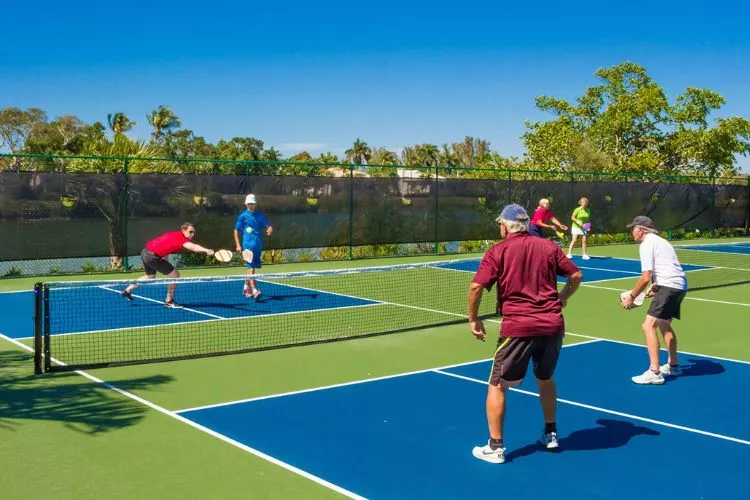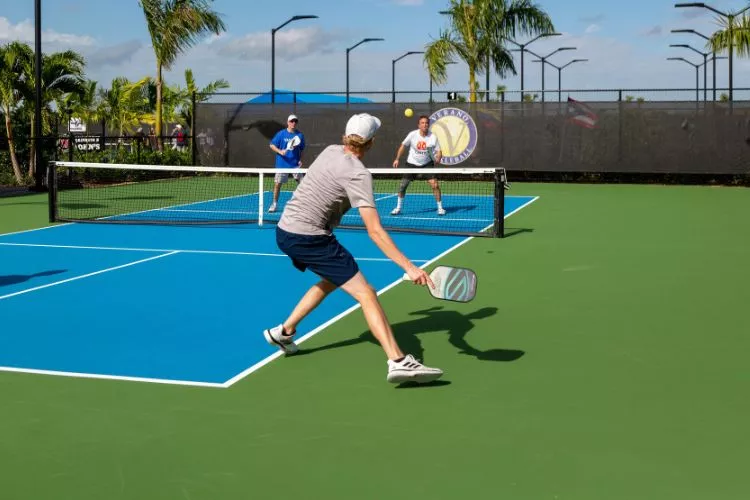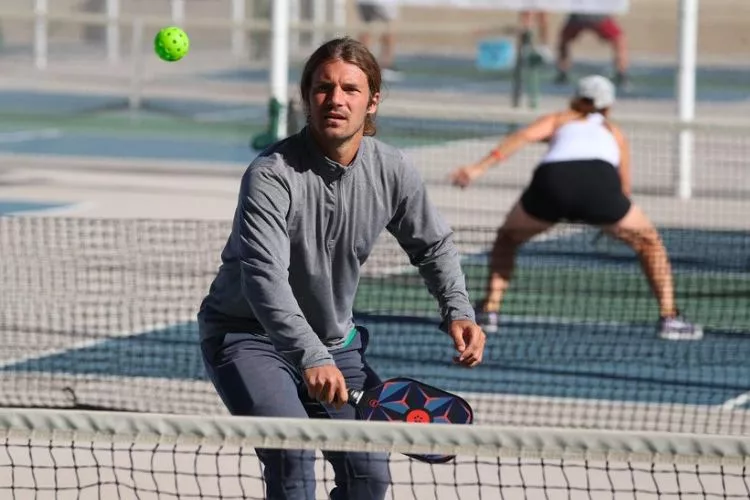Pickleball, known for its fast-paced and exciting gameplay, is a sport that combines elements of tennis, badminton, and table tennis.
However, do you know what is a non volley zone in pickleball?
Well, it’s one of the unique features of pickleball, and it is also known as the “Kitchen.”

This designated area on the court plays a crucial role in the game and understanding its rules and strategic importance is essential for any pickleball player.
what is a non volley zone in pickleball?
The Non-Volley Zone is a 7-foot area on both sides of the net that extends from the net to the non-volley zone line.
Its purpose is to prevent players from executing volleys near the net, adding an additional element of control and placement to the game.
By restricting volleys within this zone, players are encouraged to rely on strategic shot placement, soft shots (dinks), and well-executed third shot drops.
Understanding the Non-Volley Zone Rules
To fully comprehend and respect the Non-Volley Zone rules, it is crucial to grasp its dimensions and location on the pickleball court.

Dimensions and Location of the Non-Volley Zone
The Non-Volley Zone occupies a rectangular area that spans 7 feet from the net and is evenly divided between both sides of the court. This zone begins at the net and is marked by a non-volley zone line on each side of the court. These lines are parallel to the net, extending 7 feet back from it.
When playing pickleball, it is essential to remain aware of the Non-Volley Zone’s boundaries to avoid committing faults or infringing the rules inadvertently.
Prohibition of Volleys within the Non-Volley Zone
The Non-Volley Zone rule states that players may not hit the ball out of the air (volley) while their feet are inside the Non-Volley Zone. This rule applies regardless of whether the shot is executed with a forehand or a backhand technique.
The purpose of this rule is to promote a level playing field, emphasizing the importance of strategy, soft shots, and precise shot placement.
Violating the Non-Volley Zone rule results in a fault, causing the opposing team to earn a point. It is crucial to exercise caution and mindfulness when approaching the net to avoid committing a fault.
Strategies and Tips for Playing in the Non-Volley Zone
With the Non-Volley Zone being a critical area of the pickleball court, developing effective strategies and mastering the necessary techniques within this zone becomes imperative for players of all skill levels.

Proper Footwork and Court Positioning
One of the keys to success in the Non-Volley Zone is maintaining the correct footwork and court positioning.
Being in the Non-Volley Zone strategically can provide players with a defensive advantage, as it allows them to position themselves closer to the net, ready to react to incoming shots and put pressure on their opponents.
To achieve optimal footwork and court positioning, players should focus on staying light on their feet, pivoting smoothly, and being prepared to move into and out of the Non-Volley Zone quickly.
By mastering these fundamental footwork techniques, players can execute shots confidently while minimizing the risk of stepping into the Non-Volley Zone.
Effective Shot Selection and Placement
Playing in the Non-Volley Zone necessitates careful shot selection and precise shot placement. While volleys are prohibited within this area, players have several shot options that can set them up for success.
Dinks, or soft shots, are a common shot type used within the Non-Volley Zone. These shots require a gentle touch and allow players to keep the ball low and close to the net.
Executing dinks effectively can put pressure on opponents, forcing them into uncomfortable defensive positions.
Additionally, shots aimed at strategic placements within the opponent’s court can be highly effective. Targeting the corners or sidelines of the court can force opponents to move more, creating opportunities for offensive shots or defensive mistakes.
Anticipating and Handling High Balls in the Non-Volley Zone
While players strive to keep the ball low and minimize their opponents’ chances for aggressive shots, high volleys or balls near the net can present challenges. Being prepared to handle these high balls while adhering to the Non-Volley Zone rule is crucial.
When faced with a high volley near the net, players can employ a combination of footwork, positioning, and technique to handle the shot effectively.
By taking a step back from the Non-Volley Zone and executing an overhead shot, players can maintain their position while avoiding any faults. Practice is key to mastering this technique, as it requires precision and control.
Advanced Strategies for Utilizing the Non-Volley Zone
Once players have a solid foundation in the Non-Volley Zone, they can explore more advanced strategies that can give them an edge over their opponents.

Mastering Dinking in the Non-Volley Zone
Dinking, one of the most important skills in pickleball, involves hitting soft shots close to the net that make it difficult for opponents to execute strong offensive shots. Players can gain a significant advantage by mastering the art of dinking within the Non-Volley Zone.
To execute precise and deceptive dinks, players should focus on maintaining a relaxed grip, using a gentle wrist motion, and aiming for the opponent’s feet or the edges of their non-volley zone.
By causing opponents to hit upwards or step into the Non-Volley Zone, players can disrupt their game and create scoring opportunities.
Creating Opportunities with the Third Shot Drop
The third shot drop is a strategic shot used to regain control of the game. It involves hitting a soft shot into the opponent’s non-volley zone after the return of serve, allowing players to move forward while their opponents are forced to stay back and volley.
Perfecting the third shot drop from the Non-Volley Zone requires practice and precision. By taking advantage of this shot, players can control the pace of the game and ensure they maintain a strategic advantage throughout the point.
Frequently Asked Questions (FAQs)
Can the ball bounce in the Non-Volley Zone on a serve?
Yes, the ball can bounce within the Non-Volley Zone on a serve. The Non-Volley Zone rule only applies to volleys or hitting the ball while it is still in the air.
What happens if a player steps on the Non-Volley Zone line?
If a player steps on or touches the Non-Volley Zone line while executing a shot, it is considered a fault. The fault results in the opposing team earning a point.
Is there a Non-Volley Zone in tennis as well?
No, tennis does not have a Non-Volley Zone like pickleball does. The Non-Volley Zone in pickleball is unique and adds an additional element of strategy to the game.
Conclusion:
Mastering the Non-Volley Zone (Kitchen) in pickleball is essential for players looking to take their game to the next level.
Understanding the rules, developing effective strategies, and honing the necessary techniques within the Non-Volley Zone can provide a competitive edge.
By respecting the Non-Volley Zone and incorporating it into their gameplay, players can enjoy a more strategic and rewarding pickleball experience.

Pickleball’s more than a game to me—it’s a passion. I write, sharing its highs and lows, the thrills and the lessons. Some tales might draw you to the court, while others give a hint of the game’s magic. So, curious about my journey? Ready to dive deep into the world of pickleball with me? Let’s go.
